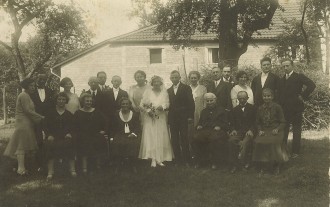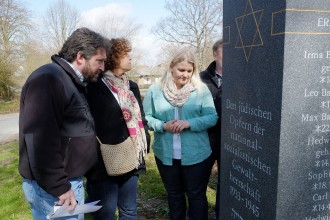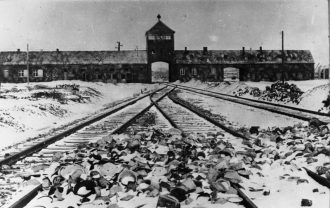
Walter was the youngest son of Hermann and Röschen Tobias. He was born on October 23, 1901 in Hamm on Sieg. Different from his brothers, he didn’t follow in his father’s footsteps into the butcher’s business. We actually don’t know what kind of apprenticeship he did. He referred to himself as a locksmith and electrician. We know he attended electrician classes at a technical school in Bingen on Rhine during the winter of 1921/1922, but he didn’t finish his first semester. The enrollment lists of the following semesters don’t exist anymore, so we don’t know if he graduated. In Hamm he was registered as an electrician.
In the summer of 1931, he married Selma Bähr of Haaren in Westfalen. She was born there on October 8, 1904, the eldest daughter of Hermann Bähr and Minna Buchthal. Walter and Selma probably met through Walter’s neighbor Alex Bachenheimer, who’s brother Leo lived in Haaren. We don’t know exactly where the wedding celebration took place, but it was not the house of Hermann and Rosa Tobias on Scheidter Street. It most likely took place in the Westerwald area, because the slate-covered house in the background of the wedding photo is typical of the region. The pair moved to Haaren where Selma’s father Hermann Bähr ran a trading business of oil, furs and small cattle.

Selma and Walter’s first son Karl-Heinz was born on June 20, 1932. By the time their second son Erwin was born on July 11, 1933, Hitler had already seized power and the family had suffered their first bad experience with the new authorities during the boycott of Jewish shops. It was hard for Walter to find work. He helped his father-in-law with the business and worked as a parish craftsman. The people in Haaren and in neighboring villages appreciated his skills in repairing things, such as sewing machines, but he couldn’t make ends meet and had to collect welfare. The third son Kurt was born on March 10, 1935. In 1937, the SA installed signs saying “Jews unwanted.” One of these signs stood close to the Bähr’s house. That same year, Selma’s sister Irma, her husband Walter Katz and their son Martin emigrated to the Netherlands, as well as Selma’s brother Sigmund. The fourth son of Walter and Selma, Gerson, was born on September 7, 1938.
Only two months later, on Kristallnacht, in the afternoon of November 10, Walter and the other Jewish men in town were arrested and sent to Paderborn. Then the SA destroyed and looted all the shops and homes of the Haaren Jews. Minna Bähr looked on helplessly as furniture was thrown out of windows, beds were cut up and the porcelain was smashed. The next morning the men were sent to the Buchenwald concentration camp. Hermann Bähr was the first to be released in December 1938, because he had been awarded the Iron Cross during World War I. Walter was kept in Buchenwald until January 16, 1939.

In February 1939, Hermann and Minna Bähr went to Amsterdam to live with their daughter Irma and her family. Now Walter, Selma and their four children were alone in Haaren. They moved into the house of Hermann and Minna and tried to sell it in order to get the means to follow the others. First they entered into negotiations with Nazi party member Konrad Klär, but he hesitated to pay the agreed price. In April 1941, Klär was given the house per command and the Tobias family had to move into the “Judenhaus,” the property of Otto Emmerich, where all the Jewish families were gathered until their deportation. Then Walter and Selma sold their house to the shoemaker Joseph Hoppe, but the Nazis rejected the sale, claiming that Hoppe was known to be a “friend to Jews” and obviously they wanted to prevent Walter and Selma from getting the money.
Since the fall of 1939, Karl-Heinz and Erwin had lived at the Jewish orphanage in Paderborn so they could attend the local Jewish school. In 1941, their brother Kurt attended as well. In February 1942, both the orphanage and the school were closed and the three brothers were sent back to Haaren. On January 8, 1942, their sister Zilla was born. Four families and several single persons lived in the Emmerich house at the time. After deportations to Riga and Theresienstadt during 1942, the Tobias family were the last ones left in Haaren. On February 27, 1943 a command ordered their arrest and they were taken to a collection point in Bielefeld. The train left for Auschwitz on March 3. More than 500 people were squeezed and locked up in cattle cars with no food, no water, no sanitation and no heating for three days.
When the train arrived in Auschwitz in the early morning, snow lay on the ground and it was bitter cold. The deported were selected right away after they’d stumbled out of the cars: women, children and the elderly were sent into the gas chambers. The young and strong men were sent to work. Although Walter was 41 years old and a very small person, he was selected to work in Auschwitz-Monowitz where “IG Farben” was about to build a huge chemical factory. His inmate number was 105047. Walter stayed in Monowitz for almost two years, which is an incredibly long time considering the murderous conditions. Maybe his manual skills were in demand and saved him. Between July 1943 and February 1944, he was at the infirmary several times, but his injuries had not been recorded. In January 1945, when the Russians came closer, Auschwitz was closed and th prisoners were relocated to different concentration camps further west. Walter arrived in Buchenwald on January 26, 1945.

On March 3, Walter was selected to work as a building fitter at the “Kommando Eschershausen,” only 90km from his home town of Haaren. The previous inmates of this camp had built an underground factory in an old mine during the last months. The Volkswagen Werke planned to produce the new V1-bombs there. When Walter arrived in Eschershausen he propbably was deployed for road building and clearing trees. Atrocious working conditions, no adequate protection, food and clothing, as well as sadistic guards, killed many of the forced laborers. At the end of March this camp was also closed and the prisoners were sent to other camps. Some of them were killed in a bomb raid near Celle, others were killed in a massacre committed by the SS and some made it back to Buchenwald.
On April 10, only one day before the US Forces liberated Buchenwald, the SS sent more than 9,000 prisoners on death marches to different destinations. Walter’s group was driven southeast to the Czech border. Only a small percentage of these men, who could barely walk anymore, arrived in Theresienstadt by May 6. The Ghetto was under the direction of the Red Cross since May 2, but only liberated by the Russians on May 8. On May 18, 1945, ten days after the liberation, Walter died there at the age of 43, being completely exhausted.
His siblings claimed for compensation in the 1950s and were granted the total of 3,300 DM which was calculated to be the gap of income between what Walter had earned since 1938 and what he should have been able to bring in if he hadn’t been persecuted. It’s a ridiculously tiny restitution for what he had to suffer, although no money could ever compensate the loss of seven lives and one that hadn’t even begun. Selma was said to have been pregnant when she was deported to Auschwitz. Her parents and her sister’s family had been arrested in the Netherlands and were killed as well. Her brother Sigmund had made it to Uruguay, but when he was made aware of being the only survivor of the family, he committed suicide in Montevideo in 1948.
Bibliography:
- Jost Wedekin „Das Schicksal der jüdischen Familien Bähr und Tobias aus Haaren“
- Johannes Büttner „Wege in die Emanzipation – Jüdisches Leben auf dem Dorf“
- Deportationen aus Westfalen nach Auschwitz 1943
Further sources:
- Archive Gedenkstätten Buchenwald und Mittelbau-Dora
- Data sheet of Walter Tobias, Auschwitz
- Death record of Walter Tobias, Theresienstadt
Interviews:
- Ernest W. Michel (* July 1, 1923, Mannheim), was in the same transport from Paderborn to Auschwitz and also in Monowitz and Buchenwald.
- Israel Löwenstein (* March 28, 1925, Berlin) was also deported from Paderborn to Auschwitz and selected to work in Monowitz.
Family tree:
Generation 1
- Walter Tobias (1901-1945) ∞ Selma Bähr (1904-1943) Haaren/Paderborn
Generation 2
- Hermann Tobias (1865-1940) ∞ Rosa Levy (1861-1935) Hamm/Sieg
- Hermann Bähr ∞ Minna Buchthal, Haaren/Paderborn
Generation 3
- Jakob II. Tobias (1833-?) ∞ Knendel „Hannchen” Tobias (1840-1866) Oberdreis/Puderbach
- Jakob Levy (1816-1898) ∞ Klara Löwenberg (1822-1890) Schupbach
- unknown
- unknown
Generation 4
- Herz Tobias (1798-1860) ∞ Olisa Herz (1801-1864) Oberdreis/Puderbach
- Jakob I. Tobias (1803-1864) ∞ Malchen Benjamin (1815-1861) Oberdreis/Puderbach
- Heymann Levi ∞ Rifka Katz
- Gumbrich Löwenberg ∞ Lea Josef, Schupbach
- unknown…
